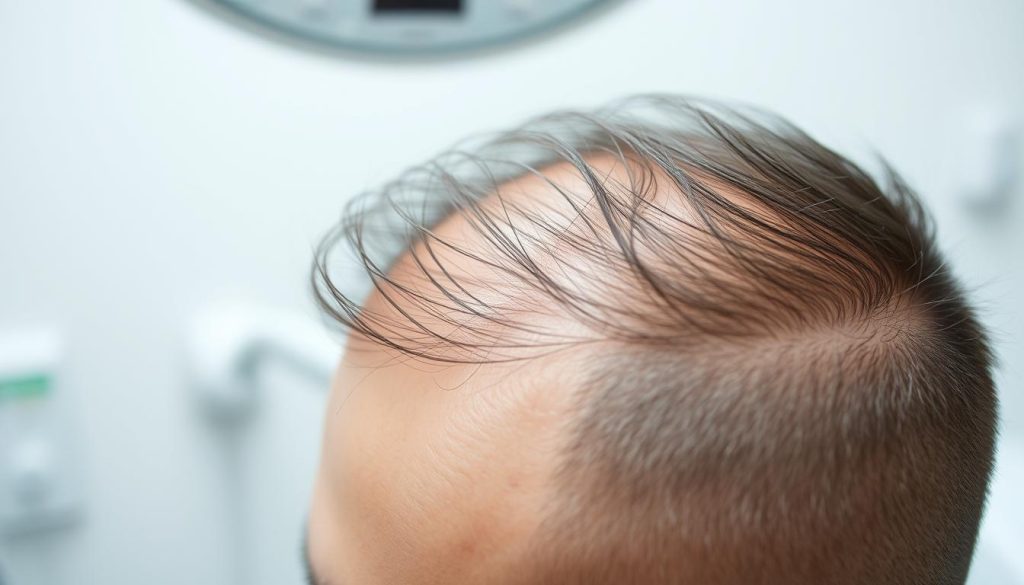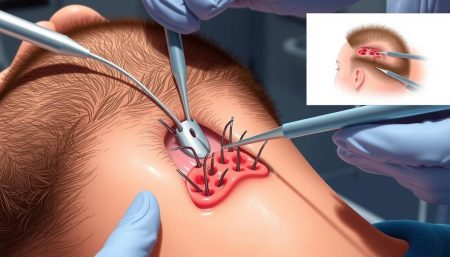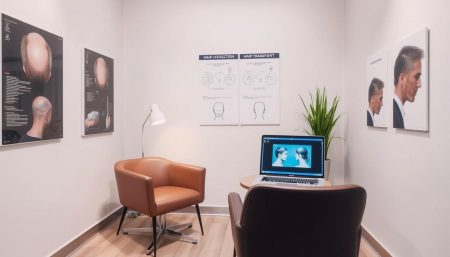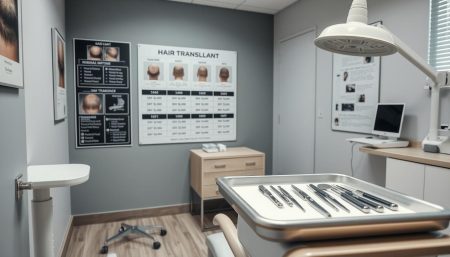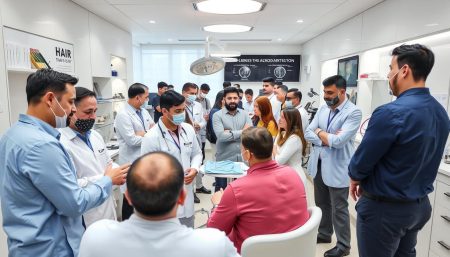Many people look into hair transplant surgery for hair growth. It’s key to know about the hair transplant side effects that can happen. This surgery is mostly safe but can have risks and complications. Knowing about these can help you make a smart choice and deal with any issues after surgery.
To explore hair transplant side effects means getting ready for the treatment’s success. It’s as important to know the risks as the benefits. This way, you can face hair loss treatment with full knowledge of what might come up during recovery.
Choosing a surgeon is not just about their skill. It’s also about their wisdom and care. They guide you through the short and long-term side effects. Like any health journey, learning and adapting are key, and understanding hair transplant effects is part of that.
Hair Transplant Side Effects: An Overview
Thinking about a hair transplant? It’s key to know the common complications after hair transplant and post-operative side effects. This part covers the wide range of experiences, from minor issues to serious health concerns that can happen after the surgery.
Every person’s recovery from a hair transplant is different. But, some common problems include swelling, redness, and a bit of pain right after. These usually go away in a few days to weeks. Yet, some side effects can last longer, affecting your health and the transplant’s success.
Many patients feel itching and numbness. These feelings are usually short-term but can be uncomfortable. Also, folliculitis, which is inflammation of the hair follicles, and shock loss, where hair falls out temporarily, can be tough to deal with.
- Immediate swelling and discomfort
- Persistent redness and numbness
- Folliculitis and shock loss
While most side effects don’t last long, worries about long-term issues like uneven hair growth or scarring are common. These are common complications after hair transplant that need careful handling and clear expectations from experts.
Learning about post-operative side effects and choosing a skilled surgeon can help reduce risks. Knowing what might happen helps set realistic goals for the best results. For more on managing and understanding hair transplant side effects, check out detailed clinical data and patient stories here.
Knowing about these possible issues can help you make better choices for your hair restoration. It helps match your hopes with what’s possible and makes recovery easier.
The Risks of Hair Transplant Procedures
Thinking about getting a hair transplant? It’s key to know the dangers of hair transplant procedures. These risks fall into two groups: immediate and long-term. Each has its own set of challenges and possible problems.
Short-Term Risks and Immediate Reactions
Right after a hair transplant, you might feel swelling, redness, and discomfort. These symptoms are common and usually go away. But, they’re important to think about when you’re deciding if a hair transplant is safe and right for you.
Long-Term Health Considerations
Looking ahead, there are long-term hair transplant surgery risks to watch out for. These could include ongoing nerve pain, scar tissue issues, and uneven hair growth. These problems can change how you look and feel for a long time. So, choosing to get a hair transplant is a big decision that needs careful thought.
The table below shows these risks, comparing short-term and long-term concerns:
| Immediate Risks | Long-Term Risks |
|---|---|
| Swelling and Redness | Persistent Nerve Pain |
| Bleeding | Scar Tissue Development |
| Temporary Pain | Irregular Hair Patterns |
Potential Side Effects of Hair Restoration
Hair restoration can be rewarding but comes with side effects. These can be physical or emotional, affecting everyone differently. The effects of hair transplantation can last long, impacting health and happiness.
It’s key to understand all risks of hair loss treatments. Knowing these helps set realistic hopes and prepares for any issues that might arise.
Brief switching of hair density and texture can happen after transplant. It’s important to talk about the emotional side of changes in appearance too. This affects how well a patient recovers and feels about their new look.
- Shock loss of transplanted and surrounding hair (Effluvium)
- Altered sensation at the transplant site
- Possible infection and scarring
- Extended swelling or bruising
- Psychological distress and adjustment challenges
| Side Effect | Short-Term | Long-Term |
|---|---|---|
| Effluvium | Common | Rare |
| Infection | Possible | Low Risk |
| Altered Sensation | Often Temporary | May Persist |
| Psychological Impact | Varies | Can be Long-Lasting |
This table shows the many sides of hair transplantation. It’s important to counsel patients well and plan for all possible outcomes. With the right preparation, patients can face their hair restoration journey with less worry and more happiness.
Common Complications After Hair Transplant
Modern hair transplant procedures are safer and more effective. Yet, infection risks post-hair transplant and scarring after hair restoration can happen. These issues are not just physical but also affect how you feel about yourself.
Infection Risks Post-Surgery
Infections are rare but serious after a hair transplant. They often happen if you don’t follow the aftercare instructions well. Signs include redness, swelling, and pain at the transplant site. If not treated quickly, these can lead to bigger health problems.
Using clean equipment, applying antibiotics as directed, and keeping your scalp clean are key to avoiding infections.
Scarring and Unnatural Hair Growth
Scarring is another problem after hair restoration. It can look like small white dots or bigger scars from strip harvests. Getting hair to grow naturally after a transplant also depends on how the grafts are placed.
Teaching patients about what to expect and using advanced grafting methods can help avoid these issues.
Here’s a quick guide on how to prevent and treat infections and scarring:
| Complication | Preventive Measures | Treatment Options |
|---|---|---|
| Infection | Use of sterilized equipment, prescribed antibiotics, maintaining a clean scalp | Antibiotics, professional medical care |
| Scarring | Advanced grafting techniques, proper post-operative care | Surgical revision, laser therapy |
| Unnatural Hair Growth | Strategic graft placement, using modern transplant technology | Corrective hair transplant, cosmetic products |
Post-Operative Side Effects of Hair Grafting
It’s key to know the risks of hair transplant and post-surgical complications of hair grafting before getting the procedure. After surgery, you might experience side effects. These are usually short-term but need watching to ensure a smooth recovery.
The first 24 to 48 hours can be marked by swelling, redness, and scalp tightness. These are normal as your scalp gets used to the new grafts. But, it’s important to watch for signs that might mean you need to see a doctor.
- Persistent redness and swelling beyond the first few days
- Significant or unusual pain, which might indicate infection
- Any discharge from the surgical sites
- Signs of graft rejection or failure
Patients should have realistic hopes and follow their surgeon’s care advice closely. This helps avoid risks of hair transplant problems. Regular check-ups are key to keep the healing on track and handle any post-surgical complications of hair grafting right.
Identifying Adverse Effects of Hair Transplantation
Hair transplantation is usually successful, but it’s key to know about possible side effects. Being alert to any odd symptoms after the procedure helps get quick medical help. This can prevent long-term problems.
Recognizing Allergic Reactions
Allergic reactions are a big adverse effect of hair transplantation that needs fast action. Symptoms like itching, redness, swelling, or pain at the transplant site are signs. Sometimes, it’s because of the anesthesia used. It’s vital for both patients and doctors to spot and treat these signs early to avoid bigger health issues.
Persistent Pain or Discomfort
Persistent pain or discomfort is another serious side effect. It might mean an infection or healing problem. Unlike the usual soreness that goes away in a few days, this pain lasts longer. Seeing a doctor is necessary to check for serious problems that could slow down healing.
Here’s a table showing the common signs of allergic reactions versus usual post-op symptoms. It helps tell the difference between normal recovery and signs of trouble:
| Usual Post-Operative Symptoms | Signs of Allergic Reactions |
|---|---|
| Mild swelling | Excessive swelling and redness |
| Temporary numbness | Itching or hives |
| Typical soreness | Sharp or persistent pain |
Hair Transplant Surgery Risks: In-Depth Analysis
An in-depth analysis of hair surgery risks shows a range of possible problems. These go beyond the usual hair transplant side effects. This part looks at the less talked about, but very important, safety issues of hair restoration.
Hair transplantation can bring back hair growth, but it comes with risks. From small issues to big problems, knowing these risks is key for anyone thinking about this surgery.
- Scalp infection, though rare, is a serious worry. It can happen from dirty tools or bad care after surgery.
- Swelling and bruising around the eyes and forehead can happen. These usually go away in a few days.
- Sensitivity or numbness on the scalp can last for weeks or months.
There are deeper risks tied to the surgery itself. The area where hair is taken can be harmed. This might make it thinner if not handled right.
- Looking at the donor area to see if it has good hair follicles.
- Picking the right procedure, like FUE or FUT, based on your situation and what you hope to get.
- Following care after surgery to lower infection risk and help healing.
This in-depth analysis of hair surgery risks wants to give people the info they need. It helps them understand the good and bad of hair transplant side effects.
Psychological Impact of Hair Loss Treatment Complications
The journey through hair restoration goes beyond just physical changes. It touches on deep emotional realms. For many, the hope of regaining self-esteem clashes with the reality of post-procedure outcomes. This clash leads to a complex emotional response.
Dealing with Expectation vs. Reality
People often have high hopes for a full head of hair. But when the results don’t meet these expectations, it can be tough. This can lead to a deep psychological impact, as patients adjust their self-image and expectations.
Stress and Anxiety Post-Transplant
Stress and anxiety after hair restoration may not show up right away. Anxiety can range from mild worry to severe stress that affects daily life. This anxiety can make people unhappy with the surgery results, creating a cycle that needs help to break.
| Emotional Response | Frequency | Severity |
|---|---|---|
| Initial Satisfaction | High | Moderate |
| Long-term Satisfaction | Variable | Moderate to Low |
| Post-surgical Stress | Common | High |
| Anxiety over Results | Frequent | High |
The emotional ups and downs after hair restoration surgery highlight the need for psychological support. Managing expectations and coping with stress and anxiety are as important as the physical healing. These emotional aspects should be a key part of post-surgical care.
Minimizing Dangers of Hair Transplant Procedures
Modern medicine has made it easier to reduce hair transplant surgery risks and minimize complications. Patients can now make safer choices with the right knowledge. Here are important steps to keep patients safe.
- Choosing the Right Clinic and Surgeon: It’s vital to pick a place and doctor who are well-qualified and experienced.
- Pre-Operative Consultation: Talking with your doctor about your health and medications before surgery is key.
- Post-Operative Care: Carefully following your doctor’s advice after surgery helps avoid problems.
| Preparation Step | Importance | Impact |
|---|---|---|
| Comprehensive Medical Review | Essential for tailor-made surgery plans | Reduces unforeseen adverse reactions |
| Skilled Surgical Execution | Directly correlates to success rates | Decreases risk of infection and poor aesthetics |
| Diligent Post-Surgery Care | Key to fast and effective recovery | Essential in minimizing complications like scarring |
With thorough checks before surgery and choosing the right doctors, hair transplants can be safer. Good care after surgery makes recovery smoother. This shows a strong focus on patient health.
Medication-Induced Side Effects After a Hair Transplant
After a hair transplant, patients often face both good and bad effects from their meds. These drugs help with pain and prevent infection. But, they can also cause medication-induced side effects. It’s key to understand these effects and navigating post-transplant medication well for a safe recovery.
Potential Interactions and Their Consequences
Medications after surgery can mix badly with each other or with drugs you already take. This can make healing harder. Such mix-ups might make side effects worse or make the meds less effective. This needs careful watching by doctors.
Navigating Post-Surgical Medications Safely
To avoid problems from medication mix-ups or bad reactions after transplant, follow these steps:
- Thorough Assessment: Make sure to tell your doctor about all your current meds.
- Monitoring for Symptoms: Keep an eye out for any new symptoms that could mean a problem.
- Frequent Communication: Keep talking to your healthcare team about any worries you have.

By watching for medication-induced side effects and using smart strategies for navigating post-transplant medication, patients can protect their health. This helps ensure their hair transplant is a success.
Techniques to Reduce the Risks of Hair Restoration
Using techniques to minimize hair restoration risks is key in hair transplant surgery. Giving patients safe hair transplant strategies makes treatments more effective. It also makes patients happier and safer. Here, we look at advanced methods and important rules to lower hair restoration risks.
- Choosing experienced surgeons who know the latest techniques.
- Following strict sterilization to avoid infections.
- Checking the patient’s health history for the best treatment.
- Using precise grafting to protect the scalp.
The table below shows how certain practices make hair transplant safer and more confident for patients:
| Technique | Impact on Safety | Patient Benefit |
|---|---|---|
| Advanced Imaging for Accurate Donor Harvesting | Reduces risk of damaging existing follicles | Enhanced natural-looking results |
| Customized Sedation Protocols | Minimizes discomfort and possible allergic reactions | Improves overall procedure comfort |
| Meticulous Post-Operative Care | Lowers infection rates and speeds up healing | Shorter recovery time |
It’s vital to use safe hair transplant strategies from the start to aftercare. These techniques to minimize hair restoration risks prevent problems. They also build trust between the patient and the medical team. This leads to a successful hair restoration journey.
Understanding the Healing Process After Hair Transplant
After a hair transplant, knowing the healing process post-hair transplant is key. This knowledge helps manage recovery and sets expectations for the journey.
Normal Healing vs. Complications
Normal healing includes minor redness, swelling, and scalp tightness, which usually goes away in a few days. But, complications like too much bleeding or infection need quick medical help. It’s important to know the difference to act fast and get the right treatment.
Timeline of Recovery and Dealing with Side Effects
The recovery time can take several months. Right after, you might feel some pain and numbness, which should go away in a week. It’s key to manage side effects and keep the area clean and cared for to help healing.
| Timeframe | Expected Healing Milestones | Recommended Actions |
|---|---|---|
| Week 1-2 | Scab formation and shedding | Keep scalp dry and avoid direct sunlight |
| Month 1-3 | Hair fall and regrowth | Maintain gentle hair care routine |
| Month 4-6 | Visible hair growth | Consult with specialist for growth enhancers |
| Month 6-12 | Denser hair appearance | Continue regular check-ups |
Keeping in touch with healthcare providers is vital for managing hair transplant recovery well. Being informed and watchful helps avoid risks and improves chances for a good outcome.
Professional Guidance on Managing Hair Transplant Side Effects
When looking for a fuller hairline, the post-operative phase can be tough. It’s filled with worries about managing hair surgery effects. Here, empathy and knowledge come together, shining a light of hope for those getting hair restoration.
Understanding hair transplant complexities goes beyond a simple grasp. That’s when experts offer their professional advice on hair transplant. They help navigate the journey with care and insight.
Talking regularly with healthcare professionals is key. They create a recovery plan that fits your needs. Their watchful eye and experience help spot healing details that others might miss.
Professionals share recovery stories, bringing relief and reassurance to those facing side effects. They guide patients through the recovery, using a structured approach to manage hair surgery effects.
As this article ends, one thing is clear: recovery after hair transplant surgery is not alone. With professional advice, people can face and manage side effects with confidence. Each piece of advice is given with care, aiming to restore hair, peace of mind, and quality of life.
FAQ
Q: What are the common side effects following a hair transplant procedure?
A: You might feel scalp pain, swelling, bruising, and numbness. These usually go away in a few weeks.
Q: Could a hair transplant lead to long-term health problems?
A: Most side effects are short-term. But, rare long-term issues like chronic pain or nerve damage can happen.
Q: What are the possible side effects on psychological well-being?
A: You might feel stressed or anxious if the results aren’t what you expected. It’s key to have realistic hopes and get support.
Q: Are there risks of infections or complications after a hair transplant?
A: Yes, there’s a chance of infection. Scarring and unnatural hair growth are also risks. But, modern methods and care can lower these chances.
Q: What should I watch out for immediately after hair grafting?
A: Look out for swelling, bruising, and mild pain. Watch for signs of infection or graft rejection. If you see anything concerning, call your surgeon.
Q: How can I minimize the dangers of hair transplant procedures?
A: Pick a skilled surgeon, follow all instructions, and take good care of your wounds. This can help avoid complications.
Q: Can I experience adverse effects from medications post-hair transplant?
A: Yes, you might have allergic reactions or drug interactions. Talk to your doctor about your medications to avoid problems.
Q: How can techniques reduce the risks associated with hair restoration?
A: New surgical methods, precise grafting, and strict cleanliness are key. They help lower the risks.
Q: What’s the normal healing process like after a hair transplant?
A: Healing involves scabbing and healing of the areas where hair was taken and put. This usually takes a few weeks. If you have ongoing redness, pain, or swelling, see a doctor.
Q: How essential is professional advice in managing hair transplant side effects?
A: Getting advice from a pro is very important. They help with side effects, ensure healing, and offer support. Make sure to have regular check-ups with your doctor.












